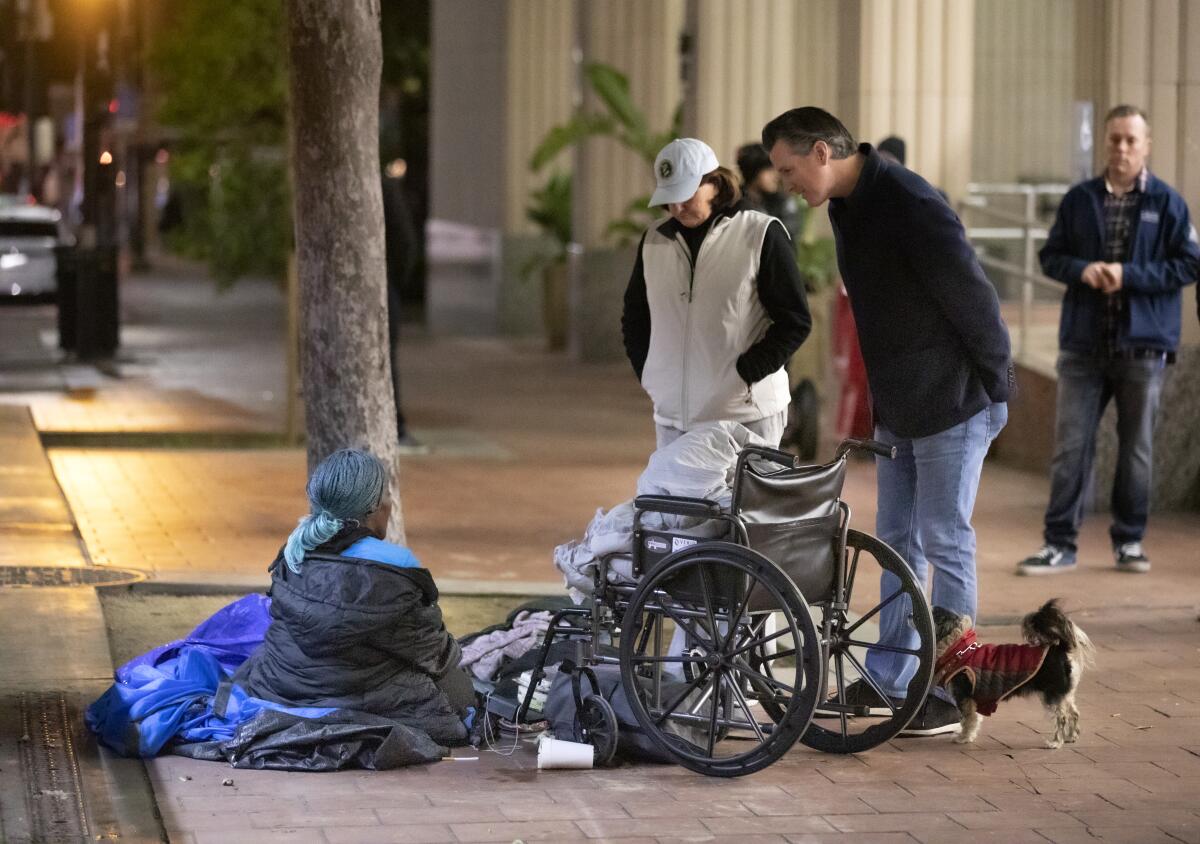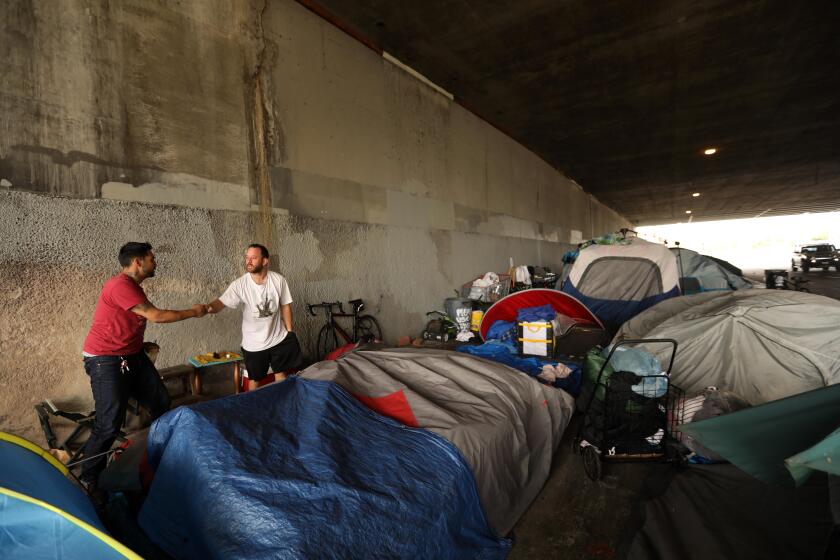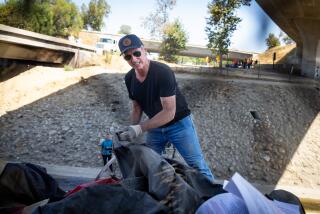Does California need ‘another cook in the kitchen’ to fix homelessness? Newsom says yes

SACRAMENTO — California lawmakers will gather Wednesday to hear Gov. Gavin Newsom deliver his annual State of the State address and will no doubt applaud any promise he makes to zero in on homelessness. But that doesn’t mean they’ll agree with him.
There is a growing rift in Sacramento political circles over how best to address a crisis that has swelled so much in the past year that more than 151,000 people are now living on the streets and in shelters across the state.
Newsom has already proposed spending an additional $750 million to get people into housing this year — on top of the more than $1 billion that the state is still doling out from previous allocations — and $695 million to expand homeless services under Medi-Cal.
On Wednesday, the governor also may elaborate on a new plan that, he says, will create more accountability by carving the state into still-undecided regions. State officials would then pick an entity in each region to distribute the $750 million, bypassing the existing reliance on allotting money directly to cities and counties, and other local organizations. The details are vague.
Meanwhile, another plan floated by Assemblyman Miguel Santiago (D-Los Angeles) and the Los Angeles Homeless Services Authority would allocate $2 billion a year to combat homelessness, instead of the one-time jolt of funding that Newsom prefers.
Santiago says the plan, which he expects to be introduced as a bill on Friday, is complementary to what the governor wants. But the differing approach is a likely harbinger of broader dissent that could dominate discussions at the Capitol in coming months as the state budget is hammered out amid growing criticism that existing efforts on homelessness are failing.
And, for Angelenos in particular, the discussions could add another layer of confusion as Mayor Eric Garcetti continues to negotiate his own deal with the Trump administration to address homelessness in L.A. These talks have been happening independent of the governor’s office for months. Last week, U.S. Housing and Urban Development Secretary Ben Carson met with Garcetti to announce a working group that could lead to more funding and access to federal land, though under what conditions remains unclear.
“There is an unprecedented level of intensity focused on the homeless crisis in this state, so this will not be going away any time soon,” said L.A. County Supervisor Mark Ridley Thomas, a co-chair of Newsom’s statewide task force on homelessness. “We are obligated to deliver and I think the governor is laser-focused on that.”
At the core of the debate, at least among state officials, is a need for accountability, to show that taxpayer money is successfully reducing the number of people on the streets when, in many places, it’s not. Instead, more people continue to become homeless than are helped into housing. In 2018, for example, 133 people escaped homelessness each day in L.A. County, but another 150 people became homeless.
Will another single shot of money, as the governor wants, make a difference? And can any sum help when those charged with spending it can’t seem to agree on what needs to be done?
“Homelessness is a crisis, one that demands every level of government to not only step up with more resources, but also to ensure money spent is having the largest possible effect at getting people off the street,” said Jason Elliott, senior counselor to the Governor for Housing and Homelessness.
There are, however, two points on which elected officials — from the governor to mayors — can agree: There is little effective or uniform tracking of current spending at any level of government, and there are few repercussions for local governments that spend money without results. This week, one member of the Assembly called for an audit of state homeless funding to decipher where it had gone.
Newsom, in particular, is under increasing pressure to show results. Even before taking office, he promised to select a point person in his administration to tackle the issue cohesively. But that effort has yet to solidify, leading to criticism.
President Trump, in particular, has called out the state for driving the nation’s rise in homelessness. On Tuesday, during his visit to Los Angeles, the president said federal intervention might be necessary if L.A. doesn’t “clean it up fast.”
“If they can’t do it themselves, we’re going to do it,” Trump said. “The federal government is going to take it over, we’re going to do it.”
The governor has suggested that his latest plan will lead to real progress, breaking through red tape and increasing collaboration by giving the state more control of where its money goes. The existing mishmash has allowed some jurisdictions to duck their fair share of work, some officials argue. And it stymies local governments that do want to act because, at the ground level, successfully helping a homeless person often requires multiple levels of government working together.
“The various funding streams are fragmented,” Sacramento Mayor Darrell Steinberg said at an event last week at USC. “It’s an alphabet soup.”
Help us inform our reporting about the homelessness crisis in California by submitting your questions.
An emergency shelter, for example, could be opened by a city — but mental health services would likely come through the county. There are many places in the state where local leaders — mayors, city council members or members of county boards of supervisors — contend neighboring cities and counties won’t cooperate.
Under the governor’s plan to split the state into regions, the organizations holding the purse strings of state funding could be nonprofits, local governments or something else — but the California Department of Social Services, now a relatively small player, would become an overseer with a goal of compelling collaboration.
“Californians deserve to have every level of government working together — across parochial boundaries — to avoid duplication of services and maximize results across metropolitan areas,” Elliott said.
But some legislators view Newsom’s plan as reinventing the wheel in the middle of an emergency. Rather than eliminate confusion, the plan has been criticized as a way to create it by adding another source of money and another layer of bureaucracy.
“This is just one aspect of the governor’s proposal that has us scratching our heads,” said Michelle Cabrera, executive director of the County Behavioral Health Directors Assn. “What we are hearing is not, ‘Gosh, we really need another cook in the kitchen.’”
Currently, there is not much the state can do to force local governments to coordinate, but Newsom’s plan would formalize that ability to intervene.
Separately, the governor’s homelessness task force, led by Ridley-Thomas and Steinberg, also has suggested creating a constitutional amendment as another way to achieve that goal. It would allow the state to sue local governments if they fail to meet agreed-upon benchmarks for housing homeless people. That plan would require a two-thirds majority in the Legislature to place it on the ballot. Newsom has expressed interest in the idea but hasn’t endorsed it.
Oakland Mayor Libby Schaaf said cooperation between her city and the county of Alameda had been a problem, and she agrees that the current system involves “too much bureaucratic red tape and siloing of different governmental roles” that can be used as excuses for inaction. She added that the push to keep local control of money was “often used as a thinly veiled rallying cry for NIMBYs and exclusion.”
Still, when asked about Newsom’s plan, Schaaf said she was hesitant to embrace a regional structure with few details, given the potential for losing the ability to make local decisions when Oakland is her responsibility.
“When people want to scream at their government, they come to City Hall,” she said. “They come to the mayor’s office — and in my case, they sometimes come to my house.”
There are signs that Newsom’s plan might not get quick approval. At a committee hearing last week, lawmakers were skeptical.
“It wasn’t clear what the new approach was addressing,” said Assemblyman Phil Ting (D-San Francisco) after the hearing. “People already feel like we have plenty of state employees. Why do we need more state employees to administer a new pot of money?”
Santiago said that, without annual funding, “it’s a hard mountain to climb because you need to be able to plan for next year’s services.”
“We have ongoing money for education, we have ongoing money for transportation, we have ongoing money for healthcare,” he said. “We have got to have ongoing money for homelessness because, if we don’t, the problem will continue to grow.”
Newsom will likely engage with the Legislature in coming weeks. But legislators will probably forge ahead with their own proposals too. As they debate, consensus remains elusive for those working on the front lines of the crisis.
“I think that as we hit fever pitch, people are throwing spaghetti up against the wall,” Cabrera said.
More to Read
Sign up for Essential California
The most important California stories and recommendations in your inbox every morning.
You may occasionally receive promotional content from the Los Angeles Times.








